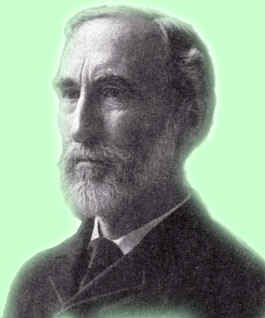Josiah Willard Gibbs (1839-1903)
 Josiah Willard Gibbs was born in New Haven, Connecticut on February 11, 1839
the only son of Josiah Willard Gibbs. His father was a Yale University professor
best known for finding translators for the mutineers of the Amistad slave ship.
He had done so in order to help the mutineers tell their side of the story,
which was very controversial at that time. In 1873, his first published work
entitled "Graphical Methods in the Thermodynamics of Fluids" was released.
He was 34 years of age at the time and was just starting to reveal his genius
to the rest of the world. His first paper included the formula which he is probably
most famous for: dU = T dS — P dV. His second published work came out
that same year with the title of "A Method of Geometrical Representation
of the Thermodynamic Properties of Substances by Means of Surfaces". (photo
courtesy)
Josiah Willard Gibbs was born in New Haven, Connecticut on February 11, 1839
the only son of Josiah Willard Gibbs. His father was a Yale University professor
best known for finding translators for the mutineers of the Amistad slave ship.
He had done so in order to help the mutineers tell their side of the story,
which was very controversial at that time. In 1873, his first published work
entitled "Graphical Methods in the Thermodynamics of Fluids" was released.
He was 34 years of age at the time and was just starting to reveal his genius
to the rest of the world. His first paper included the formula which he is probably
most famous for: dU = T dS — P dV. His second published work came out
that same year with the title of "A Method of Geometrical Representation
of the Thermodynamic Properties of Substances by Means of Surfaces". (photo
courtesy)
From 1876 to 1878, he released two memoirs that were eventually combined under the title of "On the Equilibrium of Heterogeneous Substances". J. D. Van Der Waals was praised for finding the phase rule, which was buried in the formulas included in this work. As one can see, he had a tendency to create long and somewhat unintelligible titles. In fact, the most often cited fault was that his work was hard to follow, even for those who were considered experts in their fields. His response to this criticism was that if anything his works were too long and did not value an individuals time as much as they should. He was known for being very brief in wording and did most of his presentations of the subject through calculations. He was regarded as being reluctant to share his thoughts until he had thoroughly substantiated them. He also did not give any reasoning for what brought him to the fields of study about which he wrote. This has led to much speculation about his motivations, none of which completely explain all of his works.
Gibbs also contributed to crystallography, the determination of planetary and comet orbits, and electromagnetic theory. James Clerk Maxwell was one of the first European scientists to recognize Gibbs as a theoretical physicist of international stature. Gibbs was also interested in the practical side of science; his doctorate was the first granted by Yale for an engineering thesis, and he received a patent (1866) for an improved type of railroad brake. His Scientific Papers appeared in 1906 (repr. 1961) and his Collected Works in 1928.

Connect with us
Contact us today